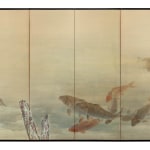Okamoto Hōsui 岡本芳水
Koi and Mooring Post, 1920s-30s
Six-panel folding screen; ink, mineral colors and gold on paper
Size 52½ x 108¼ in. (133 x 275.5 cm)
T-4748
Further images
-
(View a larger image of thumbnail 1
)

-
(View a larger image of thumbnail 2
)

-
(View a larger image of thumbnail 3
)

-
(View a larger image of thumbnail 4
)

-
(View a larger image of thumbnail 5
)

-
(View a larger image of thumbnail 6
)

-
(View a larger image of thumbnail 7
)

-
(View a larger image of thumbnail 8
)

-
(View a larger image of thumbnail 9
)

-
(View a larger image of thumbnail 10
)

Signed and sealed at right Hosui Okamoto Hosui studied painting in Kyoto under the well-know Nihonga artist Kikuchi Hobun (1862–1918). Recurring subjects in his paintings are animals, birds and flowers....
Signed and sealed at right Hosui
Okamoto Hosui studied painting in Kyoto under the well-know Nihonga artist Kikuchi Hobun (1862–1918). Recurring subjects in his paintings are animals, birds and flowers. His most famous work is a set of fusuma (sliding doors) in the Mimakuri Shrine, Tsugemura, Nara Prefecture, depicting a pair of peacocks.
Hosui received the honor to exhibit in the prestigious Bunten national art exhibition four times--in 1907, 1915, 1917, and 1918--as well as in the Tokyo Taisho exhibition of 1914. He was still active in 1927.
Okamoto Hosui studied painting in Kyoto under the well-know Nihonga artist Kikuchi Hobun (1862–1918). Recurring subjects in his paintings are animals, birds and flowers. His most famous work is a set of fusuma (sliding doors) in the Mimakuri Shrine, Tsugemura, Nara Prefecture, depicting a pair of peacocks.
Hosui received the honor to exhibit in the prestigious Bunten national art exhibition four times--in 1907, 1915, 1917, and 1918--as well as in the Tokyo Taisho exhibition of 1914. He was still active in 1927.









